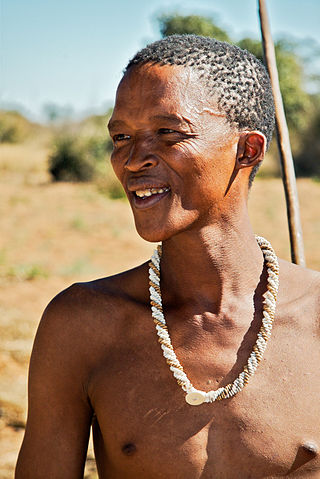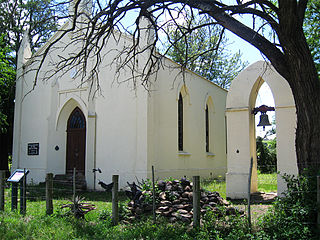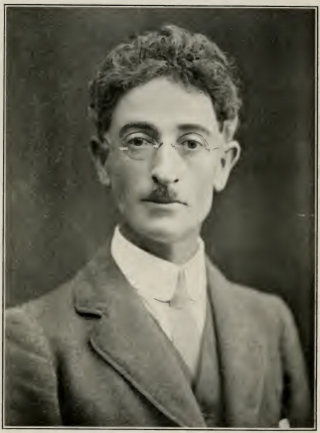Related Research Articles

KhoisanKOY-sahn, or Khoe-Sān, is a catch-all term for the indigenous peoples of Southern Africa who traditionally speak non-Bantu languages, combining the Khoekhoen and the Sān peoples. Khoisan populations traditionally speak click languages and are considered to be the historical communities throughout Southern Africa, remaining predominant until European colonisation in areas climatically unfavorable to Bantu (sorghum-based) agriculture, such as the Cape region, through to Namibia, where Khoekhoe populations of Nama and Damara people are prevalent groups, and Botswana. Considerable mingling with Bantu-speaking groups is evidenced by prevalence of click phonemes in many especially Xhosa Southern African Bantu languages.

Khoekhoe are the traditionally nomadic pastoralist indigenous population of South Africa. They are often grouped with the hunter-gatherer San peoples. The designation "Khoekhoe" is actually a kare or praise address, not an ethnic endonym, but it has been used in the literature as an ethnic term for Khoe-speaking peoples of Southern Africa, particularly pastoralist groups, such as the !Ora, !Gona, Nama, Xiri and ǂNūkhoe nations. The Khokhoe were once known as Hottentots, a term now considered offensive.

Hottentot is a term that was historically used by Europeans to refer to the Khoekhoe, the indigenous nomadic pastoralists in South Africa.

Sarah Baartman, also spelled Sara, sometimes in the diminutive form Saartje, or Saartjie, and Bartman, Bartmann, was a Khoikhoi woman who was exhibited as a freak show attraction in 19th-century Europe under the name Hottentot Venus, a name that was later attributed to at least one other woman similarly exhibited. The women were exhibited for their steatopygic body type uncommon in Western Europe that not only was perceived as a curiosity at that time, but became subject of scientific interest as well as of erotic projection.

The San peoples, or Bushmen, are the members of any of the indigenous hunter-gatherer cultures of southern Africa, and the oldest surviving cultures of the region. Their recent ancestral territories span Botswana, Namibia, Angola, Zambia, Zimbabwe, Lesotho, and South Africa.

The Griquas are a subgroup of mixed-race heterogeneous formerly Xiri-speaking nations in South Africa with a unique origin in the early history of the Dutch Cape Colony. Like the Boers they migrated inland from the Cape and in the 19th century established several states in what is now South Africa and Namibia. The Griqua consider themselves as being South Africa’s first multiracial nation with people descended directly from Dutch settlers in the Cape, and local peoples.

The Secret Doctrine, the Synthesis of Science, Religion and Philosophy, is a pseudoscientific esoteric book as two volumes in 1888 written by Helena Blavatsky. The first volume is named Cosmogenesis, the second Anthropogenesis. It was an influential example of the revival of interest in esoteric and occult ideas in the modern age, in particular because of its claim to reconcile ancient eastern wisdom with modern science. Proponents widely claim the literature contains clues as to how the nature of prayer was 'covered' and expunged from common wisdom, except for those with a keen eye.

Stutterheim is a town with a population of 46,730 in South Africa, situated in the Border region of the Eastern Cape province. It is named after Richard von Stutterheim.
A kaross is a cloak made of sheepskin, or the hide of other animals, with the hair left on. It is properly confined to the coat of skin without sleeves and used to be worn by the Khoikhoi and Bushmen / San peoples of South Africa. These karosses became replaced by a blanket. Their chiefs wore karosses of the skin of the wild cat, leopard or caracal. The word is also loosely applied to the cloaks of leopard-skin worn by the chiefs and principal men of several southern African tribes. Kaross is probably either a genuine Khoikhoi word, or else an adaptation of the Dutch kuras, a cuirass. In a vocabulary dated 1673 "karos" is described as a "corrupt Dutch word."

Elongated labia is a feature of certain Khoikhoi and other African women who develop, whether naturally or through artificial stretching, relatively elongated labia minora, which may hang up to four inches outside the rest of the vulva when they are standing in an upright position.

The Khoikhoi–Dutch Wars were a series of conflicts that took place in the latter half of the 17th century in what was known then as the Cape of Good Hope, in the area of present-day Cape Town, South Africa, between Dutch colonisers who came from the Netherlands and the local African people, the indigenous Khoikhoi.
The Prehistory of South Africa lasts from the Middle Stone Age until the 17th century. Southern Africa was first reached by Homo sapiens before 130,000 years ago, possibly before 260,000 years ago. The region remained in the Late Stone Age until the first traces of pastoralism were introduced about 2,000 years ago. The Bantu migration reached the area now South Africa around the first decade of the 3rd century, over 1800 years ago. Early Bantu kingdoms were established in the 11th century. First European contact dates to 1488, but European colonization began in the 17th century.

Twyfelfontein, officially known as ǀUi-ǁAis, is a site of ancient rock engravings in the Kunene Region of north-western Namibia. It consists of a spring in a valley flanked by the slopes of a sandstone table mountain that receives very little rainfall and has a wide range of diurnal temperatures.
In the culture of the San, an indigenous people of Botswana, Namibia, South Africa, and Angola, healers administer a wide range of practices, from oral remedies containing plant and animal material, making cuts on the body and rubbing in 'potent' substances, inhaling smoke of smouldering organic matter like certain twigs or animal dung, wearing parts of animals or 'jewellery' that 'makes them strong.' Anecdotal records reveal that the Khoikhoi and San people have used Sceletium tortuosum since ancient times as an essential part of the indigenous culture and materia medica. The trance dance is one of the most distinctive features of San culture.
Mageu, Mahewu, Mahleu, Magau (xau-Namibia), Madleke, Mabundu, maHewu, amaRhewu or amaHewu is a traditional Southern African non-alcoholic drink among many of the Chewa/Nyanja, Shona, Ndebele, Nama Khoikhoi and Damara people, Sotho people, Tswana people and Nguni people made from fermented mealie pap. Home production is still widely practised, but the drink is also available at many supermarkets, being produced at factories. Its taste is derived predominantly from the lactic acid that is produced during fermentation, but commercial mageu is often flavoured and sweetened, much in the way commercially-available yogurt is. Similar beverages are also made in other parts of Africa.

Frederick William FitzSimons, was an Irish-born South African naturalist, noted as a herpetologist for his research on snakes and their venom, and on the commercial production of anti-venom.

Fingoland was a historical territory situated in what is now the Eastern Cape, South Africa. It was inhabited primarily by the Xhosa people of the Mfengu clans, and was located in the south-west portion of the "Transkei" region.
The San religion is the traditional religion and mythology of the San people. It is poorly attested due to their interactions with Christianity.
Ancestral land conflict over the Central Kalahari Game Reserve (CKGR) arose in the 1970s between the government of Botswana and the San people (Bushmen), and is ongoing, resulting in one of the most expensive court cases in the history of Botswana.
References
- 1 2 McLeish, Kenneth (1996). AIGAMUXA. Bloomsbury Publishing. p. 23. ISBN 0-7475-2502-1.
- 1 2 Lowie, R. H. (1908). "Review". The Journal of American Folklore. 21 (81): 251. doi:10.2307/534645. JSTOR 534645.
- 1 2 Thomas, Douglas; Alanamu, Temilola (2018), African Religions: Beliefs and Practices through History, ABC-CLIO, p. 26, ISBN 9781610697521